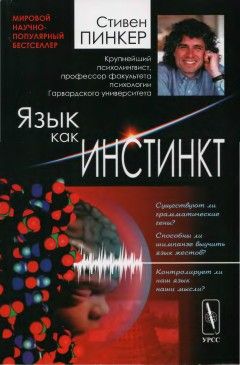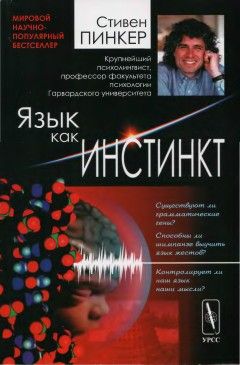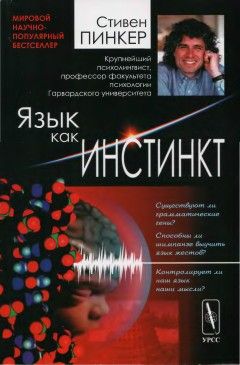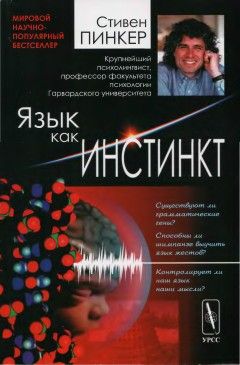Garrett M. 1990. Sentence processing // Osherson & Lasnik 1990.
Gazzaniga M. S. 1978. The integrated mind. New York: Plenum.
Gazzaniga M. S. 1983. Right hemisphere language following brain bisection: A 20-year perspective // American Psychologist, 38. P. 528–549.
Gazzaniga M. S. 1989. Organization of the human brain // Science, 245. P. 947–952.
Gazzaniga M. S. 1992. Nature’s mind. New York: Basic Books.
Geertz C. 1984. Anti anti-relativism // American Anthropologist, 86. P. 263–278.
Geisel T. S. 1955. On beyond zebra, by Dr. Seuss. New York: Random House.
Gelman S. A. & Markman E. 1987. Young children’s inductions from natural kinds: The role of categories and appearances // Child Development, 58. P. 1532–1540.
Gentner D. & Jeziorski M. 1989. Historical shifts in the use of analogy in science // B. Gholson W. R. Shadish Jr., R. A. Beimeyer & A. Houts (Eds.), The psychology of science: Contributions to metascience. New York: Cambridge University Press.
Geschwind N. 1979. Specializations of the human brain // Specific American, September.
Geschwind N. & Galaburda A. 1987. Cerebral lateralization: Biological mechanisms, associations, and pathology. Cambridge, Mass.: MIT Press.
Gibbons A. 1992. Neanderthal language debate: Tongues wag anew // Science, 256. P. 33–34.
Gibbons A. 1993. Mitochondrial Eve refuses to die // Science, 259. P. 1249–1250.
Gibson E. 1998. Linguistic complexity: Locality of syntactic dependencies // Cognition 68. P. 1–76.
Gleitman L. R. 1981. Maturational determinants of language growth // Cognition, 10. P. 103–114.
Gleitman L. R. 1990. The structural sources of verb meaning // Language Acquisition, 1. P. 3–55.
Goldsman M. 1992. Quayle quotes. Various computer networks.
Goodglass H. 1973. Studies on the grammar of aphasics // H. Goodglass & S. E. Blumstein (Eds.), Psycholinguistics and aphasia. Baltimore: Johns Hopkins University Press.
Goodman N. 1972. Seven strictures on similarity // Problems and projects. Indianapolis: Bobbs-Merrill.
Gopnik M. 1990a. Dysphasia in an extended family // Nature. P. 344, 715.
Gopnik M. 1990b. Feature blindness: A case study // Language Acquisition. P. 139–164.
Gopnik M. 1993. The absence of obligatory tense in genetic language impairment. Unpublished manuscript, Department of Linguistics, McGill University.
Gopnik M. & Crago M. 1991. Familial aggregation of a developmental language disorder // Cognition, 39. P. 1–50.
Gordon P. 1986. Level-ordering in lexical development // Cognition, 21. P. 73–93.
Gould J. L. & Marler P. 1987. Learning by instinct // Scientific American, January.
Gould S. J. 1977. Why we should not name human races: A biological view // S. J. Gould. Ever since Darwin. New York: Norton.
Gould S. J. 1981. The mismeasure of man. New York: Norton.
Gould S. J. 1985. The flamingo’s smile: Reflections in natural history. New York: Norton.
Gould S. J. & Lewontin R. C. 1979. The spandrels of San Marco and the Panglossian program: A critique of the adaptationist programme // Proceedings of the Royal Society of London, 205. P. 281–288.
Green D. M. 1976. An introduction to hearing. Hillsdale, N. J.: Erlbaum.
Greenberg J. H. (Ed.) 1963. Universals of language. Cambridge, Mass.: MIT Press.
Greenberg J. H. 1987. Language in the Americas. Stanford, Calif.: Stanford University Press.
Greenberg J. H., Ferguson C. A. & Moravcsik E. A. (Eds.) 1978. Universals of human language (4 vols.). Stanford, Calif.: Stanford University Press.
Greenfield P. M. & Savage-Rumbaugh E. S. 1991. Imitation, grammatical development, and the invention of protogrammar by an ape // Krasnegor et al. 1991.
Grice H. P. 1975. Logic and conversation // P. Cole & J. L. Morgan (Eds.), Syntax and Semantics 3: Speech acts. New York: Academic Press.
Grimshaw J. 1990. Argument structure. Cambridge, Mass.: MIT Press.
Grosjean F. 1982. Life with two languages: An introduction to bilingualism. Cambridge, Mass.: Harvard University Press.
Guy J. 1992. Genes, peoples, and languages? An examination of a hypothesis by Cavalli-Sforza // LINGUIST electronic bulletin board, January 27.
Hakuta K. 1986. Mirror of language: The debate on bilingualism. New York: Basic Books.
Hale K., Krauss M., Watahomigie L, Yamamoto A., Craig C., Jeanne L. M., & England N. 1992. Endangered languages // Language, 68. P. 1–42.
Halle M. 1983. On distinctive features and their articulatory implementation // Natural Language and Linguistic Theory, 1. P. 91–105.
Halle M. 1990. Phonology // Osherson & Lasnik 1990.
Harding R. M. & Sokal R. R. 1988. Classification of the European language families by genetic distance // Proceedings of the National Academy of Science, 85. P. 9370–9372.
Hardy-Brown K., Plomin R. & DeFries J. C. 1981. Genetic and environmental influences on the rate of communicative development in the first year of life // Developmental Psychology, 17. P. 704–717.
Harman G. (Ed.) 1974. On Noam Chomsky: Critical essays. New York: Doubleday.
Harnad S. R., Steklis H. S. & Lancaster J. (Eds.) 1976. Origin and evolution of language and speech (special volume) // Annals of the New York Academy of Sciences, 280.
Harris R. A. 1993. The linguistics wars. New York: Oxford University Press.
Hart J., Berndt R. S. & Caramazza A. 1985. Category-specific naming deficit following cerebral infarction // Nature, 316. P. 439–440.
Haugeland J. (Ed.) 1981. Mind design. Cambridge, Mass.: MIT Press.
Hawkins J. (Ed.) 1988. Explaining language universals. Basil Blackwell.
Hayakawa S. I. 1964. Language in thought and action (2nd ed.). New York: Harcourt Brace.
Heath S. B. 1983. Ways with words: Language, life, and work in communities and classrooms. New York: Cambridge University Press.
Heider E. R. 1972. Universals in color naming and memory // Cognitive Psychology, 3. P. 337–354.
Hillis A. E. & Caramazza A. 1991. Category-specific naming and comprehension impairment: A double dissociation // Brain, 114. P. 2081–2094.
Hinton G. E. & Nowlan S. J. 1987. How learning can guide evolution. Complex Systems, 1. P. 495–502.
Hirschfeld L. A. & Gelman S. A. (Eds.) 1994. Domain specificity in cognition and culture. New York: Cambridge University Press.
Hirsh-Pasek K. & Golinkoff R. M. 1991. Language comprehension: A new look at some old themes // Krasnegor et al. 1991.
Hockett C. F. 1960. The origin of speech // Scientific American, 203. P. 88–111.
Hofstadter D. R. 1985. Metamagical themes. New York: Basic Books.
Holden C. 1987. The genetics of personality // Science, 237. P. 598–601.
Holm J. 1988. Pidgins and creoles (2 vols.). New York: Cambridge University Press.
Holmes R. B. & Smith B. S. 1977. Beginning Cherokee (2nd ed.). Norman, Okla.: University of Oklahoma Press.
Hubel D. 1988. Eye, brain, and vision. San Francisco: Freeman.
Humboldt W. von. 1836/1972. Linguistic variability and intellectual development (G. C. Buck & F. Raven, Trans.). Philadelphia: University of Pennsylvania Press.
Hurford J. R. 1989. Biological evolution of the Saussurean sign as a component of the language acquisition device // Lingua, 77. P. 187–222.
Hurford J. R. 1991. The evolution of the critical period in language acquisition // Cognition, 40. P. 159–201.
Huttenlocher P. R. 1990. Morphometric study of human cerebral cortex development // Neuropsychologia, 28. P. 517–527.
Ingram D. 1989. First language acquisition: Method, description, and explanation. New York: Cambridge University Press.
Jackendoff R. S. 1977. X-bar syntax: A study of phrase structure. Cambridge, Mass.: MIT Press.
Jackendoff R. S. 1987. Consciousness and the computational mind. Cambridge, Mass.: MIT Press.
Jackendoff R. S. 1992. Languages of the mind. Cambridge, Mass.: MIT Press.
James W. 1892/1920. Psychology: Briefer course. New York: Henry Holt & Company.
Jespersen O. 1938/1982. Growth and structure of the English language. Chicago: University of Chicago Press.
Jeyifous S. 1986. Atimodemo: Semantic conceptual development among the Yoruba. Doctoral dissertation, Cornell University.
Johnson S. 1755. Preface to the Dictionary. Перепечатано в: E. L. McAdam, Jr., and G. Milne (Eds.), 1964, Samuel Johnson’s Dictionary: A modern selection. New York: Pantheon.
Joos M. (Ed.) 1957. Readings in linguistics: The development of descriptive linguistics in America since 1925. Washington, D. C: American Council of Learned Societies.
Jordan M. I. & Rosenbaum D. 1989. Action // Posner 1989.
Joshi A. K. 1991. Natural language processing // Science, 253. P. 1242–1249.
Kaplan R. 1972. Augmented transition networks as psychological models of sentence comprehension // Artificial Intelligence, 3. P. 77–100.
Kaplan S. 1992. Environmental preference in a knowledge-seeking, knowledge-using organism // Barkow, Cosmides, & Tooby 1992.
Kasher A. (Ed.) 1991. The Chomskyan turn. Cambridge, Mass.: Blackwell.
Katzner K. 1977. The languages of the world. New York: Routledge & Kegan Paul.
Kay P. & Kempton W. 1984. What is the Sapir — Whorf hypothesis? // American Anthropologist, 86. P. 65–79.
Kaye J. 1989. Phonology: A cognitive view. Hillsdale, N. J.: Erlbaum.
Keenan E. O. 1976. Towards a universal definition of «subject» // C. Li (Ed.), Subject and Topic. New York: Academic Press.
Kegl J. & Iwata G. A. 1989. Lenguage de Signos Nicaraguense: A pidgin sheds light on the «creole?» // ASL. Proceedings of the Fourth Annual Meeting of the Pacific Linguistics Conference. Eugene, Ore.: University of Oregon.
Kegl J. & Lopez A., M. H. 1990. The deaf community in Nicaragua and their sign language(s). Unpublished paper, Department of Molecular and Behavioral Neuroscience, Rutgers University, Newark. N. J. Originally presented at Encuentro Latinamericano y del Caribe de Educadores de Sordos: Il Encuentro Nacional de Especialistas en la Educacion del Sordo, November 12–17.
Keil F. 1989. Concepts, kinds, and conceptual development. Cambridge, Mass.: MIT Press.
Kenstowicz M. & Kisseberth C. 1979 // Generative phonology. New York: Academic Press.
Kim J. J., Pinker S., Prince A. & Prasada S. 1991. Why no mere mortal has ever flown out to center field // Cognitive Science, 15. P. 173–218.
Kim J. J., Marcus G. F., Pinker S., Hollander M. & Coppola M. 1994. Sensitivity of children’s inflection to morphological structure // Journal of Child Language, 21. P. 173–209.
King M. & Wilson A. 1975. Evolution at two levels in humans and chimpanzees // Science, 188. P. 107–116.
Kinsbourne M. 1978. Evolution of language in relation to lateral action // M. Kinsbourne (Ed.), Asymmetrical function of the brain. New York: Cambridge University Press.
Kiparsky P. 1976. Historical linguistics and the origin of language // Harnad, Steklis, & Lancaster. 1976.
Kiparsky P. 1982. Lexical phonology and morphology // I. S. Yang (Ed.), Linguistics in the morning calm. Seoul: Hansin.
Kitcher P. 1985. Vaulting ambition: Sociobiology and the quest for human nature. Cambridge, Mass.: MIT Press.
Klima E. & Bellugi U. 1979. The signs of language. Cambridge, Mass.: Harvard University Press.
Kluender R. & Kutas M. 1993. Bridging the gap: Evidence from ERPs on the processing of unbounded dependencies // Journal of Cognitive Neuroscience, 4.
Konner M. 1982. The tangled wing: Biological constraints on the human spirit. Harper.
Kornai A. & Pullum G. K. 1990. The X-bar theory of phrase structure // Language, 66. P. 24–50.
Korzybski A. 1933. Science and sanity: An introduction to non-Aristotelian systems and General Semantics. Lancaster, Penn.: International Non-Aristotelian Library.
Kosslyn S. M. 1983. Ghosts in the mind’s machine: Creating and using images in the brain. New York: Norton.
Kosslyn S. M. 1987. Seeing and imagining in the cerebral hemispheres: A computational approach // Psychological Review, 94. P. 184–175.
Krasnegor N. A., Rumbaugh D. M., Schiefelbusch R. L. & Studdert-Kennedy M. (Eds.) 1991. Biological and behavioral determinants of language development. Hillsdale, N. J.: Erlbaum.
Kučera H. 1992. The mathematics of language // The American Heritage Dictionary of the English language (3rd ed.). Boston: Houghton Mifflin.
Kuhl P. & Williams K. A., Lacerda F., Stevens K. N. & Lindblom B. 1992. Linguistic experience alters phonetic perception in infants by six months of age // Science, 255. P. 606–608.





